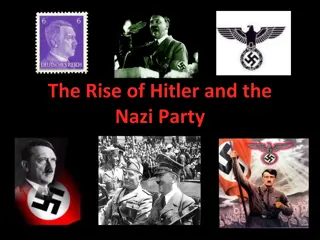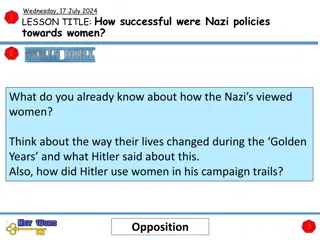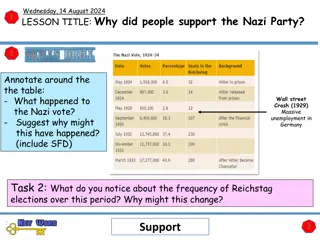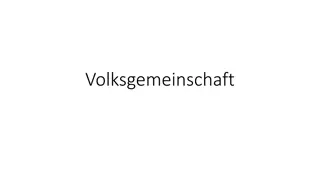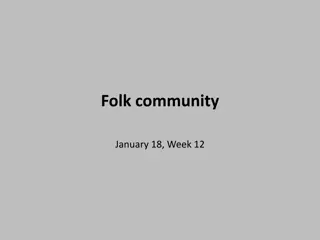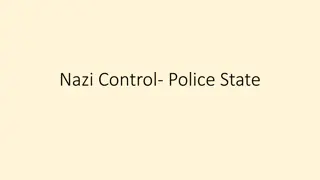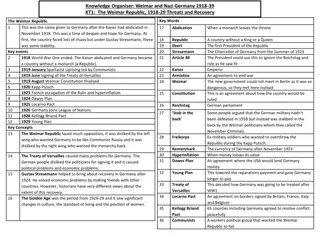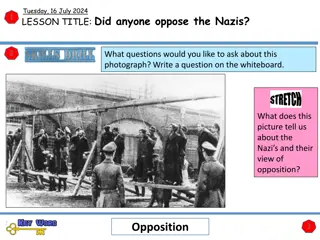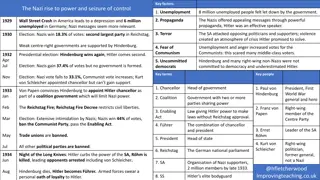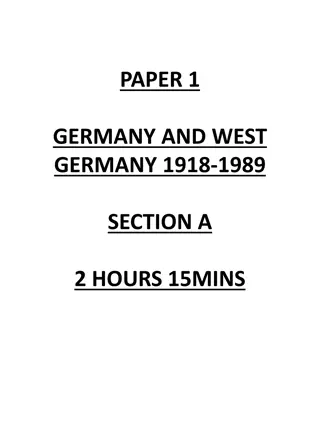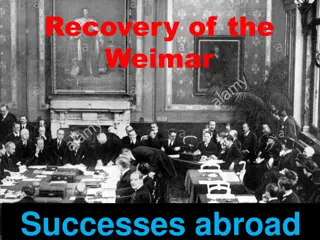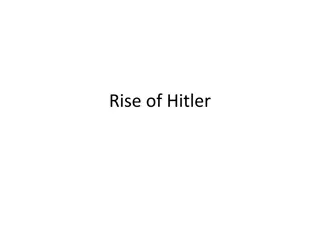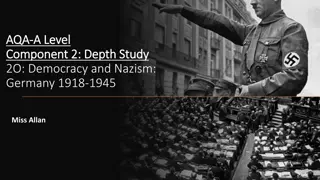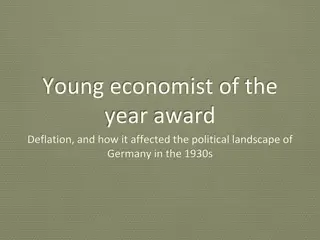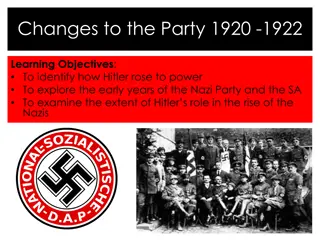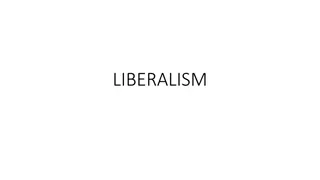Women's Role in Nazi Germany: Impact and Ideology
Explore how the Nazis shaped the role of women through policies and propaganda, emphasizing domesticity and motherhood. Analyze key figures like Joseph Goebbels and Hitler's perspectives on women's place in society. Understand the contrast between women's lives in Weimar and Nazi Germany.
Download Presentation

Please find below an Image/Link to download the presentation.
The content on the website is provided AS IS for your information and personal use only. It may not be sold, licensed, or shared on other websites without obtaining consent from the author. Download presentation by click this link. If you encounter any issues during the download, it is possible that the publisher has removed the file from their server.
E N D
Presentation Transcript
Wednesday, 17 July 2024 LESSON TITLE: How did the Nazi s change the role of women? 1 2 What did this saying translate to? What did the Nazi Party mean by this? Kinder, Kirche Kueche Write a definition of the following words; - Virtuous - Domestic 3 Women
Wednesday, 17 July 2024 LESSON TITLE: How did the Nazi s change the role of women? 1 2 What did this saying translate to? What did the Nazi Party mean by this? Children, Church, Kitchen Write a definition of the following words; - Virtuous - Domestic 3 Women
How did the Nazis change the role of women? To evaluate whether Nazi policies regarding women were successfully implemented (carried out) Mastering To compare life of women in Weimar Germany with that of Nazi Germany Securing To describe what the Nazi policies towards women were Developing
What does Hitler mean when he states that man s world is the State? Women, as a distinct social group, had a clearly defined place in the Nazi world. In a rally at Nuremberg in 1934 Hitler said that man s world is the State , while the world of woman is a smaller world. For her world is her husband, her family, her children and her house. Stephen Lee, The European Dictatorships 1918-1945 (Routledge, 1987) According to the Nazis how were the roles of men and women different?
Who was Joseph Goebbels and what was his role within Nazi Germany? In 1929, Goebbels stated: The mission of women is to be beautiful and to bring children into the world. This is not at all as.........un-modern as it sounds. The female bird preens herself for her mate and hatches eggs for him. In exchange, the male takes care of gathering food, and stands guard and wards off the enemy. What key words does Goebbels use here? Why?
Why do you think that Goebbels refers to the animal world? In 1929, Goebbels stated: The mission of women is to be beautiful and to bring children into the world. This is not at all as.........un-modern as it sounds. The female bird preens herself for her mate and hatches eggs for him. In exchange, the male takes care of gathering food, and stands guard and wards off the enemy. What is woman s role within society (the mission of women ) according to Goebbels?
How did the Nazis try to ease women out of the workplace? The initial policy was to ease women out of the top levels of the civil service, law, medicine and politics. Women were induced to stay at home by new marriage credits and child bonuses. The gradual decline of unemployment, however, created a new demand for labour. The result was the steady recruitment of women into both agriculture and industry, the total reaching 5.2 million by 1938. Stephen Lee, The European Dictatorships 1918-1945 (Routledge, 1987) Did the Nazis remove women completely from the workplace? Give reasons for your answer using the source and your own knowledge.
Using the knowledge you have gained today (and from previous lessons) and slides 9-11, complete a spider diagram with positive aspects of women's life in Nazi Germany on the left, and negative aspects on the right. Women were seen as the centre of the German family What was life like for women in Nazi Germany? Women lost their jobs to improve male employment figures
Women and the Family in Nazi Germany The mission of women is to be beautiful and to bring children into the world. This is not as un-modern as it sounds. The female bird preens herself for her mate and hatches eggs for him. In exchange, the male takes care of gathering food, and stands guard and wards off the enemy. Joseph Goebbels, 1929 The Nazis, however, had very old fashioned views of women s place in society. They emphasised the differences between men and women and believed that nature had created each for different purposes. They believed that men should be the breadwinners and earn a living to support their families. Men were also to be responsible for decision making and providing protection, e.g. during times of war. They believed women s role in life should be to bear many children and ensure the domestic comfort of their families, e.g. cooking and cleaning. Women were expected to be dependent on men both financially and emotionally, and to obey their husbands. Women should not be involved in politics, the Nazis believed. They soon took away women s right to vote. The Nazis also felt it was wrong for women to enter paid employment for two main reasons. Firstly, this would mean neglecting their family duties. Secondly, every woman in employment was seen as taking a job from a man. The Weimar Republic had a very progressive attitude towards women s rights. Women, as well as men, were entitled to vote from the age of 20. In many other European countries at this time this type of equality was but a distant dream. For example, in Britain many women had to wait until the age of 30 to vote, while all men over 21 enjoyed this democratic right. Women were also encouraged to stand for election to the Reichstag. By 1933 10% of Reichstag members were female. In the Weimar period women were also encouraged to enter into professional careers. Many women became teachers, doctors, lawyers, judges and civil servants. By 1933 there were 100,000 women teachers and 3,000 women doctors. Again, this was a very progressive move, as in many European countries women mainly occupied less well paid jobs such as cleaners, cooks and office secretaries. The Nazis directed a large volume of propaganda at women to encourage them to lead the kind of lives the Nazis approved of. They often used the propaganda slogan Kinder, Kirche, Kueche to sum up what they thought a woman s role was. Directly translated this means Children, Church and Cooking . To the Nazis the ideal physical appearance of a woman was blonde, blue eyed and sturdily built. She was expected to have broad hips for child bearing, and to have no interest in such things as fashion, make up or slimming. There was no question of equality under the Nazis. Women were squeezed out of jobs soon after Hitler came to power. Women doctors and civil servants were the first to go. Female teachers were not appointed. Women were forbidden from becoming judges or lawyers as they were considered too emotional.
Women as the key to achieving a Nazi community The Nazis may have been old fashioned in their attitudes to women, but they were not anti-women in the slightest. Indeed, Hitler believed that the role of the woman as mother and nurturer of the future generation was a key foundation upon which the Nazis could build a Volksgemeinschaft or people s community. The Volksgemeinschaftwas one of Hitler s most important ideas about the future of Germany. It centred on the belief that Germany was still a divided nation in the aftermath of the First World War, and that the Nazis could unite the nation by making people feel as though they were part of a very important community. The Nazis would make the German people feel they were important by stressing that Germans belonged to the Master Race , the strongest and most noble race on Earth. As a member of the Master Race one of any AryanGerman s top priorities should be to have children, to ensure the Master Race got bigger and bigger, and more and more powerful. In the idea of the Volksgemeinschaft the role of women as mothers was seen as one of the most valuable contributions to society. Nazi policy towards women was based upon two fears . Firstly, the Nazis believed the German population was growing too slowly. Germany s birth rate had fallen from 2 million to 1 million births a year, mainly due to the number of young men who had died in the First World War. This was a major problem for the Nazis as the expansion of the Master Race was one of their main ideas, and would provide the justification for their policy of Lebensraum , conquering new lands because the Master Race needed more living space. Women, as child bearers, were the key to these two main Nazi ideas. Secondly, the Nazis were afraid that their Master Race was becoming impure due to inter-marriage with inferior groups like the Jews or those with disabilities. Women, and their choice of partners, would again be the key to overcoming this perceived problem. To encourage more births Laws against abortion were strictly enforced, birth control clinics were closed down and contraception was banned. Generous marriage loans of 600 marks were given to married couples (equivalent to about 9 months wages). After each child born 25% of the loan would be scrapped, so that after 4 children you would not have to pay back anything at all. The Nazis only allowed households with four or more children to be called families . Special awards called the Honour Cross were given out to mothers in elaborate annual ceremonies held on Hitler s mother s birthday. Women who had 4 children would receive a bronze medal. Those with six children would receive a silver medal. Those with 8 or more children would receive the gold medal. Any married couples who failed to produce children were encouraged to divorce and try again with a new mate. In 1936 the Nazis began a breeding experiment called Lebensborn. Fit, healthy, single Aryan women were encouraged to visit the Lebensborn centres where they could meet with SS soldiers in a bid to encourage couples to have more Aryan children
To prevent a weakening of the Master Race Welfare support and marriage loans were restricted to Aryans only. In 1933 the Nazis began a programme of compulsory sterilisation for all people suffering from blindness, deafness, any physical disability, epilepsy, depression or alcoholism. By 1937 almost 200,000 compulsory sterilisations had been carried out. In 1935 the Law for the Protection of German Blood and Honour (The Nuremberg Laws) banned any marriages or sexual relations between Aryans and Jews. In the same year people suffering from any infectious or hereditary diseases were also banned from marrying or having sexual relations. How successful were Nazi policies towards women? Between 1933 and 1939 the number of marriages increased and there was a sharp rise in the birth rate. On the surface, it would appear that the Nazis policies had been successful. However, there is much evidence to show that this is not the case. Many historians say the birth rate would have risen without these policies, as Germany s economy was now performing well and the birth rate traditionally goes up when the economy does well. The birth rate was still only 1.5 million births per year, which was still far short of the pre-war level. Some women, including even Nazi party members, did rebel against Nazi policies towards them. Some secretly joined the underground SPD or Communist parties, arguing that women had their own unique talents and should not be confined to the home. Others flouted the laws against women in employment. However, the work they managed to get was usually low paid and low skilled. Despite initially driving women out of paid employment the Nazis were later forced to abandon this policy. In 1933 there were 11 million women in work. This actually rose to 12 million by 1939 as women were needed in the workplace to fill the shoes of the millions of German men conscripted to fight in the Second World War. However, we can see this as a temporary situation. If the Nazis had won the war it is unlikely that they would have allowed women to stay in employment once their men folk had returned home.
What does this propaganda poster tell you about Nazi beliefs concerning the role of women within Germany? Think: What can you see?
Comment on the atmosphere and mood created by the artist? E.G. Think about the background scene Why do you think that the sun has been placed where it is taking up much of the background?
How does this idyllic scene fit in with The Nazi vision of perfect society? What kind of society did the Nazis wish to create? Think about: Family Life Community
Answer the question. Give two things you can infer from this source about Nazi aims for women (4 marks). One thing I can infer is The detail to support this is Self-assess your work have you done enough to get all 4 marks? Another thing I can infer is The detail to support this is Show on your work where you have achieved your marks
J Give two things that you can infer G A03 4 marks Inference = what the source suggests about the topic given in the question One thing I can infer is The detail to support is... Another thing I can infer is The detail to support.. The detail to support will either be a quote or brief description of the specific part of the picture.
Answer the question. Give two things you can infer from this source about Nazi aims for women (4 marks). One thing I can infer is The detail to support this is Self-assess your work have you done enough to get all 4 marks? Another thing I can infer is The detail to support this is Show on your work where you have achieved your marks
How successful were Nazi policies towards women? Let s have a mini debate


